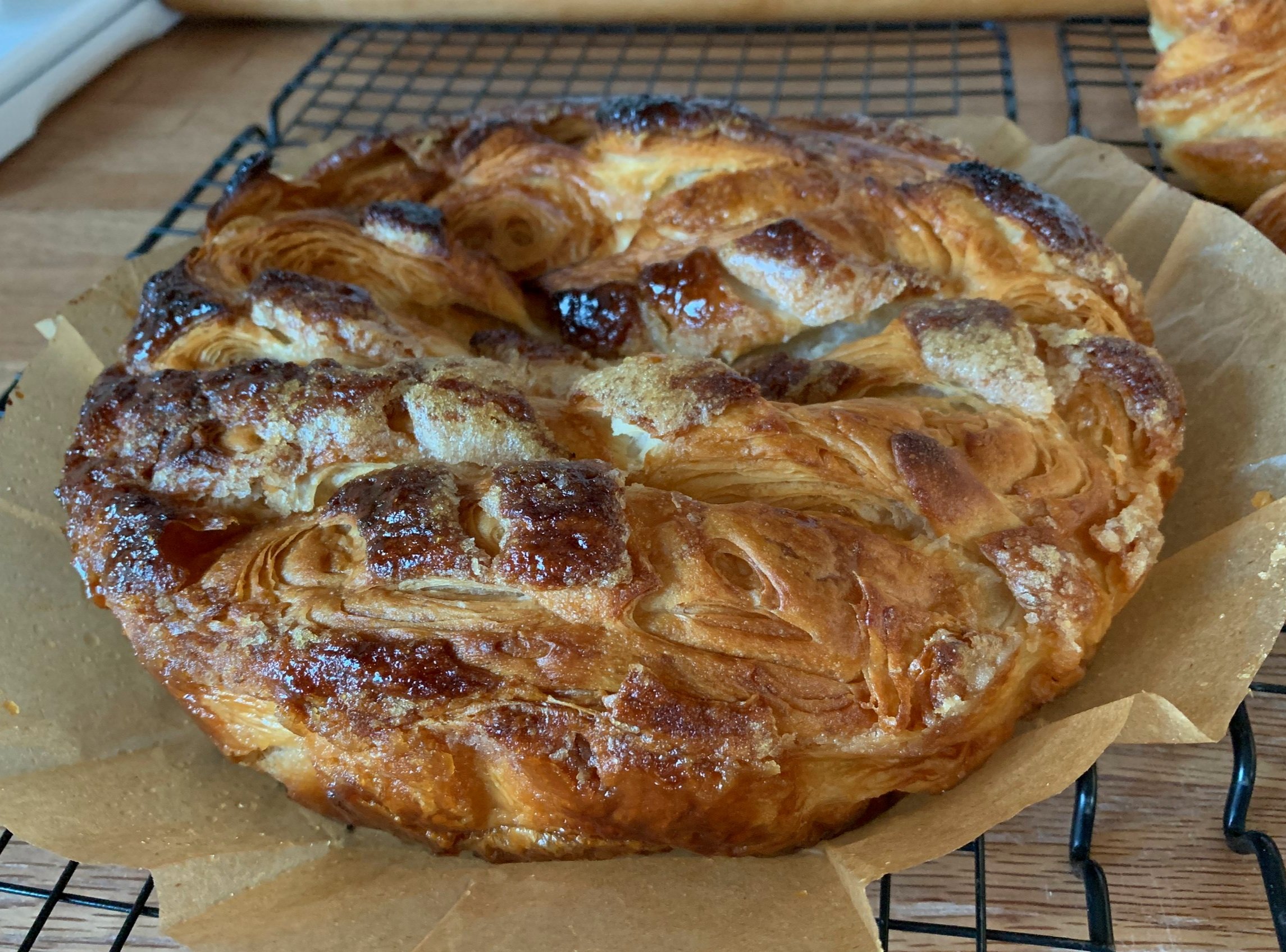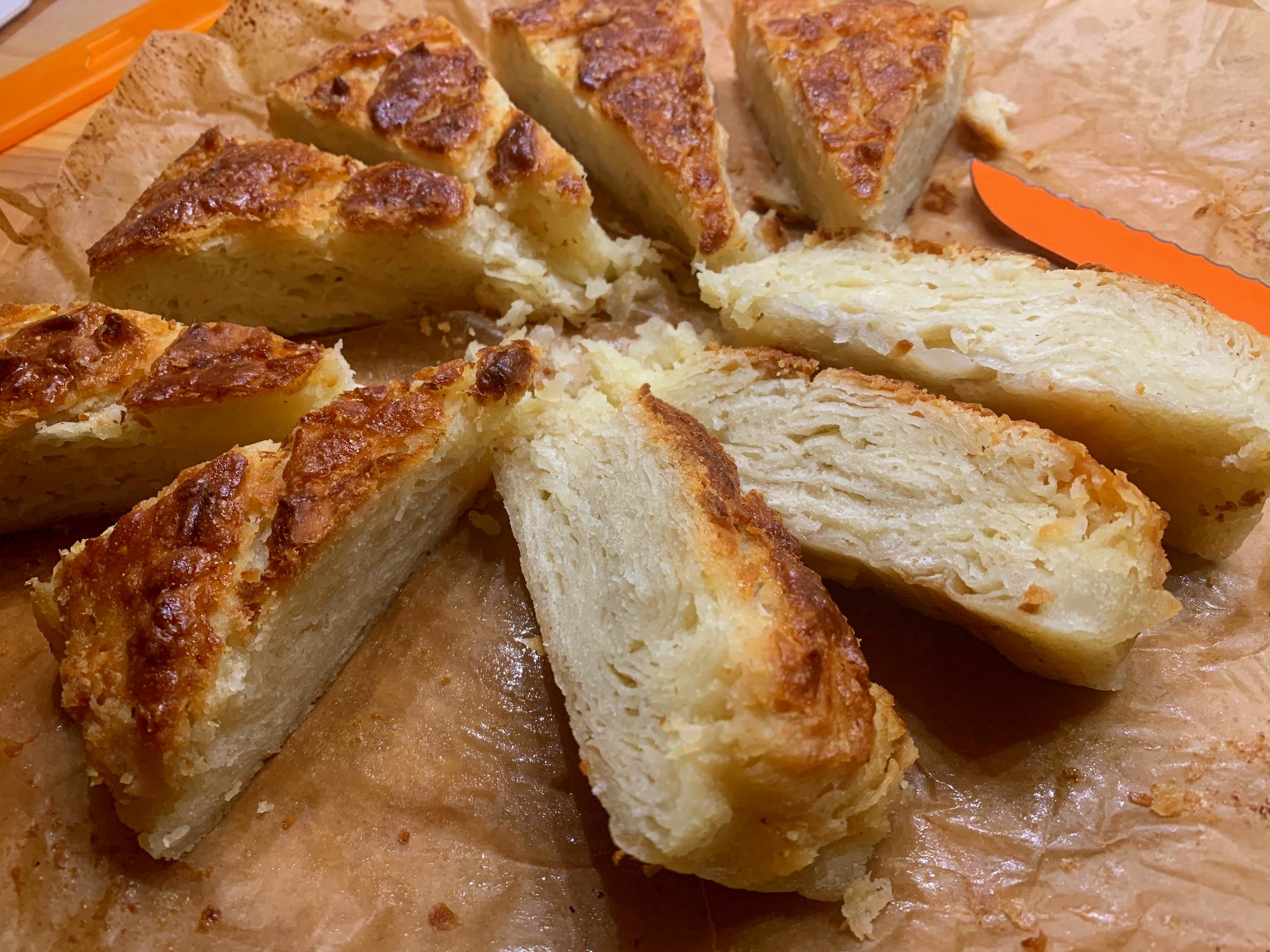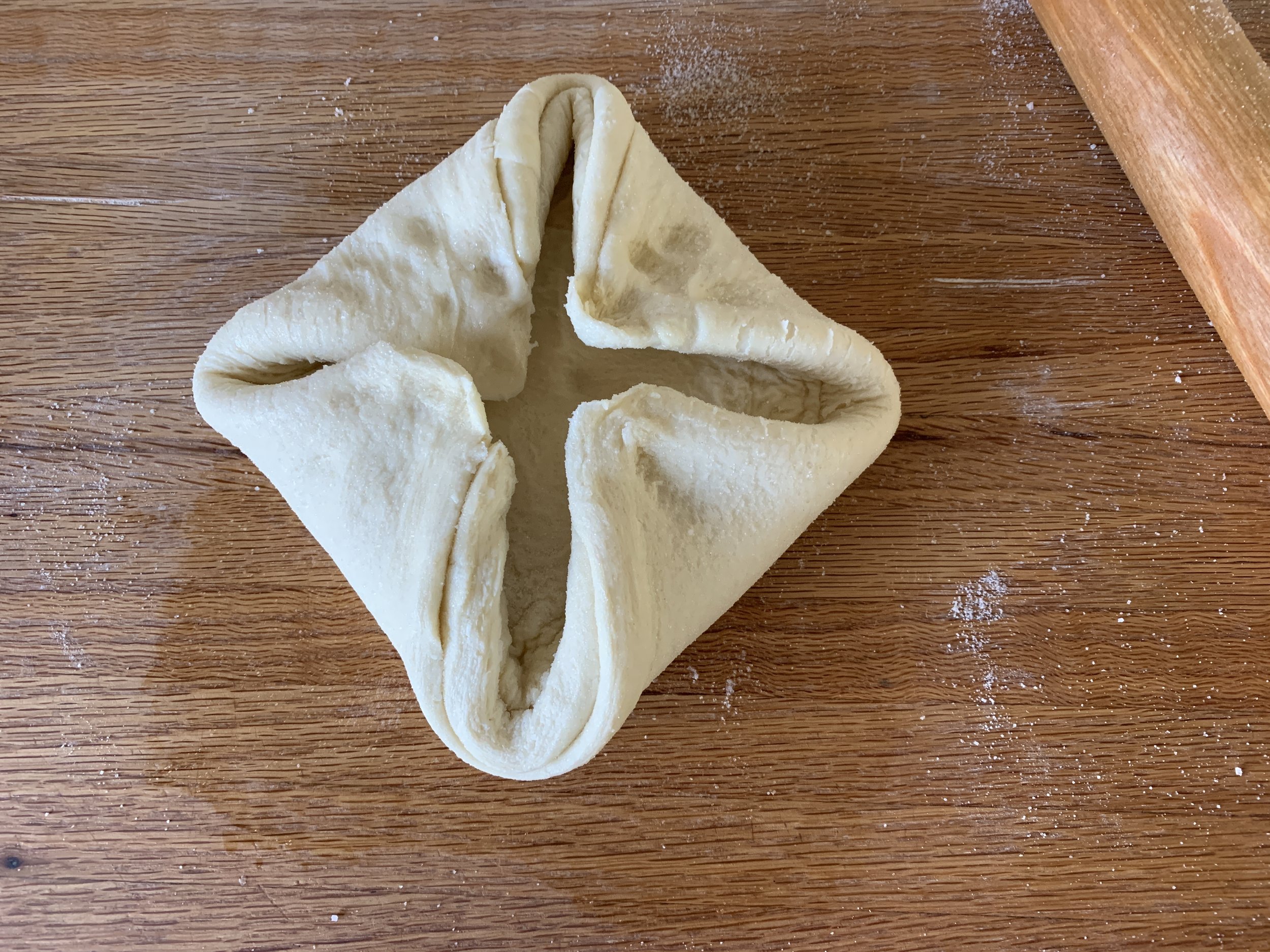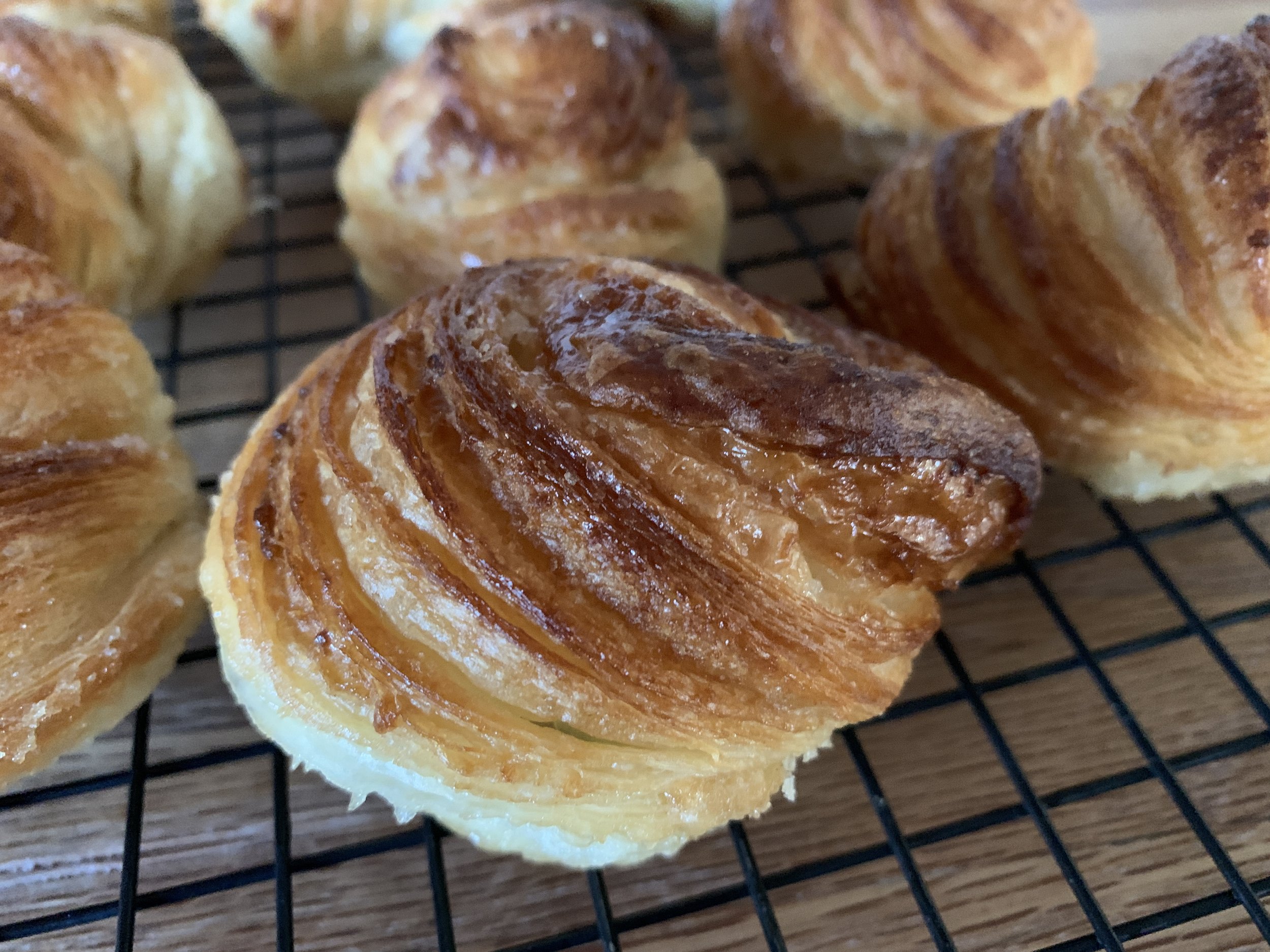Kouign-amann: Part 2
/OK. Here we are in part 2 of my Kouign-amann review. Part 1 covered shaping two versions of individual pastries. This time it’s the full sized cake version, more traditional in Brittany for slicing and enjoying at breakfast or afternoon tea. Inspired by one of King Arthur Baking Company’s “Bake of the Week” recipes back in January, 2022, I’ve had it in my “I’m-going-to-try-this” pile ever since. My how time flies!
I ended up making two versions of this cake: the first (thanks to Andrew Janjigian and the above mentioned KA Baking Co) utilized a unique approach to the sugar/butter incorporation. I thought it rather messy and the end result not as flaky, lofty or tasty as that made with my usual recipe. If you’d like to give it a try, just click the link on Andrew’s name and you can learn about his approach/recipe. There are always different ways to do things!
my result with andrew janjigian’s version
For the second using my base recipe (enough for two full sized cakes), I used half of the dough for a single cake and the rest went toward cute small spirals that are absolutely delicious!! I simply couldn’t help it. They’re stashed in my freezer as we speak.
my result with my recipe
yummy spirals
Let’s create a full sized kouign-amann! We’re proceeding with the nearly completed dough, already put through three 3-folds rolling with flour. Now it’s ready for the last sugar-rolled 3-fold.
First prep an 8” cake pan by buttering the bottom and sides then lining with a round of parchment large enough to leave an edge above the pan’s rim. This makes it easier to lift out after baking. Then butter and sugar the parchment. You can do this ahead and set it aside.
pan all prepped
Roll the dough out length wise using sugar on the rolling surface as well as on top.
ready for last three fold with sugar
Once you complete the last fold, let the dough rest at room temperature (NOT in the fridge) lightly wrapped in parchment for 20-30 minutes and then proceed with shaping/proofing/baking.
Remember I’ve made a full recipe so I divide the dough in half, using one half for one cake. You can make two cakes if you want, but I took a different route.
Roll a half portion into a rough-ish 8-9” square (still rolling in sugar) and fold the corners into the center.
corners in, ready to flip over
Turn the dough over onto the sugar dusted work surface so the corners/seams are down and roll out again (using sugar) to an approximately 8” squarish round. Don’t be too fussy about the shape - I figured it would spread out and bake into the confines of the pan, so I just went with it.
Lift the dough into the pan and tuck it in as best you can. Cut straight lines diagonally across the surface to create a diamond pattern and sprinkle with sugar.
ready to rise
Cover with lightly oiled plastic wrap or a damp towel and let proof 45-60 minutes. Meanwhile heat the oven to 400ºF (convection).
I used the other half of my dough to create a dozen spirals, rolling the dough out to about 10”x10”, cutting one-ish inch wide strips, rolling ‘em up and tucking into doubled paper baking cups rather than muffin tins. The paper cups give each a boundary so they don’t bake up against each other. My hope was they would bake more uniformly golden this way (I was right!).
just formed, ready to rise
My rise ended up at about 50 minutes. Time to bake!
I gave them 20 minutes, turned the temp down to 375ºF and rotated the trays. The spirals were well baked in another 3-4 minutes so out they came. I gave the cake an additional 10 minutes and then covered it with foil for another 10 minutes to avoid over browning. There were still some paler dough sections in the center that I wanted a bit more done.
If I’ve said it once, I’ve said it a thousand times: all ovens are different and it’s up to you to check on how things are going in there. You can do it. Let your recipe be your guide but your eyes, nose and touch be part of it too.
Oooh! Swirls and whirls of caramelized goodness. Reminds me of some of the rocks we saw in the southwest’s national parks last autumn.
Lift the cake out of the pan by grasping the paper edges and set it on a wire cooling grid.
Let it cool a bit and then . . . . . the key for me when testing out any baked laminated pastry is the initial slice to check out the layers. Fingers crossed!
While my initial concern at first inspection was for a doughy under-bake, these layers came out with a certain creaminess that compliments the caramelized exterior - flaky, light and oh so delicious.
Of course, Steve and I had to have our requisite taste test, a decadent pairing of a slightly warm slice with homemade vanilla ice cream. Swoon!
The spirals baked nicely too and turned out just the right size for a delightful morning treat. I peeled them out of the papers pretty soon after baking so as to avoid caramel-y sticking.
love these - like a petite seashell!
Always itching to test out the staying power of baked goods, a few days later I pulled a few of the spirals out of the freezer for a morning oven warm up for family guests. Delicious. There were two left which we wrapped in parchment and dared to leave out at room temp until the next morning. Another short warm up and they were still great. Good deal!
I had some of my first Janjigian test slices in the freezer along with some of the K-amann slices made with my recipe so Steve and I did another test a couple of weeks later. After a thaw/warm up of about 15 minutes in a 325º oven, we found the first version (seen on the right below) greasy, tough and not very tasty. The second was flaky with a nice texture and all around better flavor.
Mine on left
On a final note, here’s a bit about cleaning the work surface after the sugar rolling. It gets pretty messy. I prefer butcher block (my fave for all things dough) but other surfaces like Corian, granite, stainless are all much easier to clean. I do have a large polycarbonate type cutting board that I can use too, but I opted for the wood this time.
ready for cleaning
NOTE: This is about the only situation in which I rinse my rolling pin quickly under warm water to get the gooey sugar off. Pat it dry and let it sit out on a counter to dry fully. Otherwise after usual dough rolling in flour I simple rub any dough particles and flour off the pin until the next time.
For the sugary surface I use my bench or bowl scraper to push off all the loose debris into a waste basket. Then rub the surface with pieces of lemon, sprinkle with kosher salt and even a little flour to help soak up the moisture and let sit for awhile.
Rub it around to give the surface a gentle scouring, then scrape all the stuff off with a bowl scraper, wipe with a damp cloth and let air dry. The butcher block likes a mineral-oiling once in awhile too, which I might do every few months.
Lemon TIP: when I’ve zested lemons for whatever purpose, I then juice them, pour the juice into ice cube trays and freeze. The cubes are great when you need a tablespoon or two of juice for a cooking or baking project.
I then chop up the zested lemons into chunks and bag them up for the freezer. Throw a few into the garbage disposal every once in awhile to freshen things up or use a few chunks for the above cleaning process.
I think I’ve said enough folks! Happy spring and happy baking!!
just one bluebird of happiness!






















